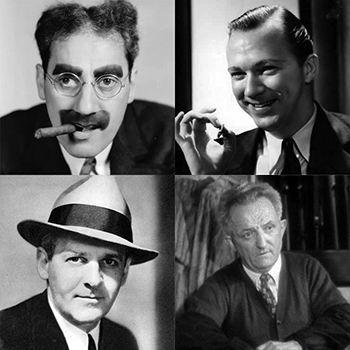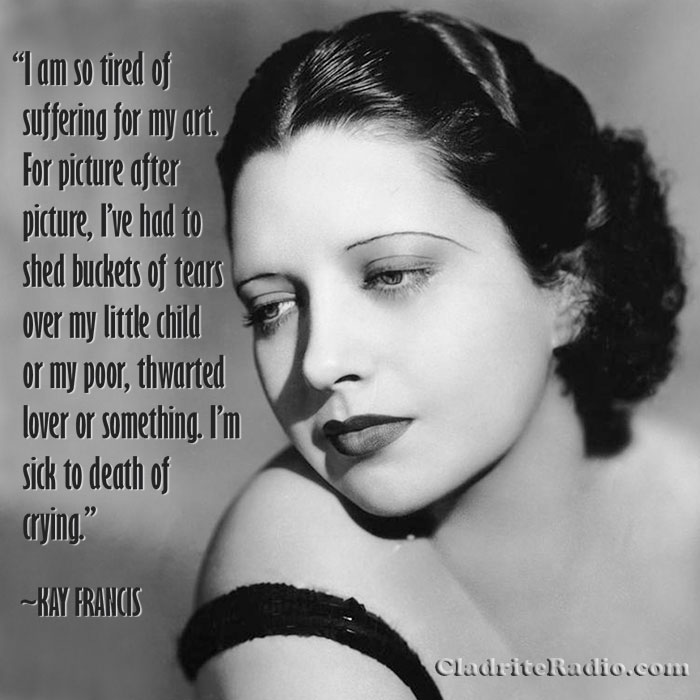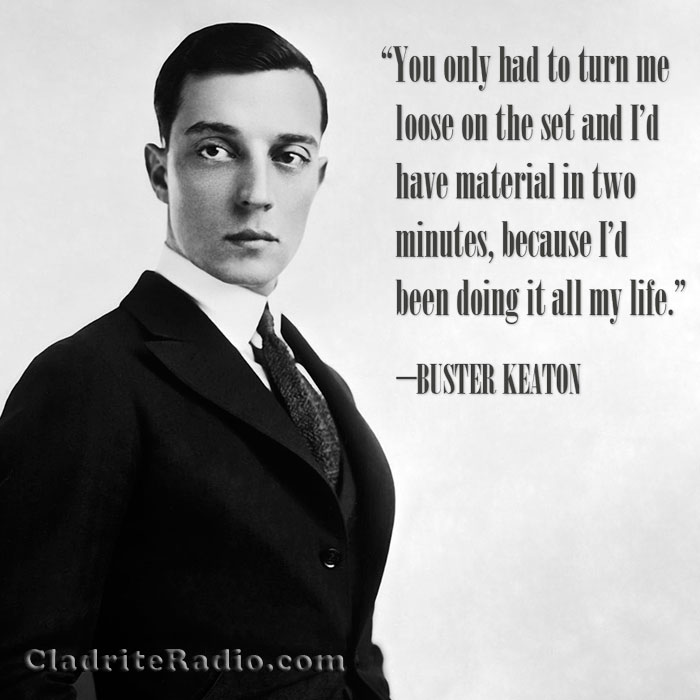Here are 10 things you should know about Irving Bacon, born 128 years ago today. The prolific character actor appeared in more than 500 films over his 47-year career.
Tag: the Marx Brothers
10 Things You Should Know About Robert Barrat
Here are 10 things you should know about Robert Barrat, born 132 years ago today. He appeared in nearly 150 films over the course of a 35-year Hollywood career.
In Search of the Mysterious Mr. Moskowitz
 One of the joys of being an old-movie buff is when an actor in a bit part sparks your interest and you start to do a little research on him or her, which causes you to tumble down a rabbit hole of odd facts and coincidences. Sometimes one finds unlikely connections between that unfamiliar performer and some much bigger names—such as when, say, Groucho Marx, Lee Tracy, and Walter Winchell have a connection to…Milton Wallace?
One of the joys of being an old-movie buff is when an actor in a bit part sparks your interest and you start to do a little research on him or her, which causes you to tumble down a rabbit hole of odd facts and coincidences. Sometimes one finds unlikely connections between that unfamiliar performer and some much bigger names—such as when, say, Groucho Marx, Lee Tracy, and Walter Winchell have a connection to…Milton Wallace?
We recently attended a screening of Blessed Event (1932), a classic precode comedy in which Lee Tracy plays a character that was obviously inspired by gossip columnist Walter Winchell, who was all the rage back then.
We were especially excited to attend the screening, as we had been informed that some footage that had long since been excised from the picture had been restored. Reportedly, it had been there all along, but only in the print that belonged to the Library of Congress. Virtually no one knew about it till Bruce Goldstein, director of repertory programming at NYC’s Film Forum, screened the print at the TCM film festival and realized what a find he’d uncovered.
For those not familiar with Winchell, we’ll catch you up just a bit: A former vaudevillian, he turned to a scandal-mongering form of journalism when his performing career wound down. His popular newspaper column was syndicated and he had a huge following on national radio, too. He was known for coining any number of phrases still used today, including the above-cited “blessed event” used to signal the pending birth of a baby (the guardians of broadcasting decency in those days were convinced that American ears were too tender for that oh-so-coarse term “pregnant”).
Winchell’s broadcasts included remotely broadcast performances by bands and singers around the country, and right before switching to those remote locations, he would blow a siren whistle and say, “Okay, America!”
In the film, as the title suggests, Tracy’s Winchell-esque character relies on the same “blessed event” catchphrase that Winchell used. But in the restored scene, a short, middle-aged, somewhat stereotypical (though not, in our opinion, disparagingly so) Jewish man, played by one Milton Wallace, shows up at the newspaper office to give Tracy a “blessed event” tip: He, Mr. Moskowitz, and his wife are soon going to have their seventh child and he thinks maybe Tracy would want to put that into his column.
Happy 112th Birthday, Kay Francis!
Fashion plate and Queen of the Women’s Pictures Kay Francis was born Katherine Edwina Gibbs 112 years ago today in Oklahoma City, Oklahoma. Here are 10 KF Did-You-Knows:
- Though Francis was born in Oklahoma City, she didn’t live there long. Much of her childhood was spent on the road with her mother, Katherine Clinton, who was an actress. At age 17, Francis, who was then attending Katherine Gibbs Secretarial School in New York City, married the first of her five husbands—one James Dwight Francis, member of a prominent (and well-to-do) Pittsfield, Massachusetts, family. That marriage, like the four other matrimonial knots Francis would eventually tie, unraveled in relatively short order.
- Shortly after her 1925 divorce, Francis decided to follow her mother’s example and pursue a life on the stage. In November of that year, she made her Broadway debut as the Player Queen in a modern-dress version of Shakespeare’s Hamlet.
- After a handful more Broadway roles, Walter Huston, her costar in the 1928 production of Elmer the Great, encouraged her to take a screen test for Paramount Pictures. She did, and was given roles in Gentlemen of the Press (1929) and the Marx Brothers‘ first picture, The Cocoanuts (1929), both of which were filmed at Paramount’s Astoria Studios in Queens, NY.
- Soon thereafter, Francis moved to Hollywood where her striking looks and model’s figure (she stood 5’9″, very tall for an actress at the time) helped her career to ascend. From 1929 to 1931, she appeared in more than twenty films.
- Warner Brothers wooed Francis away from Paramount in 1932, and it was there that she experienced her greatest success. By the mid-’30s, Francis was the queen of the Warner Brothers lot and one of the highest-paid people in the United States. From 1930-37, Francis appeared on the cover of more than 38 movie magazines, second only to Shirley Temple (who racked an astonishing 138 covers over that span).
- At Warner Brothers, Kay became known as a clotheshorse. Her ability to wear stylish clothes well was highly valued by the studio and admired by fans; in fact, she eventually came to feel that Warner Brothers put more more of a focus on her on-screen wardrobe than her film’s scripts, as she came to be unalterably associated with the sort of weepy melodramas that were then known as “women’s pictures.” We fully understand the frustration she felt at the time, but we’ll admit that we love those pictures and adore Francis’ performances in them.
- Francis’ great success came in spite of a noticable speech impediment: She pronounced R’s as W’s (ala Elmer Fudd). As such, our favorite line of Kay Francis dialogue appears in Mandalay (1934), which was directed by Michael Curtiz and in which Kay starred with Ricardo Cortez, Lyle Talbot, and Warner Oland. It’s great fun to hear her intone, “Gwegowy, we awwive at Mandalay tomowwow.”
- Francis’ personal life was something of a mess. An exceedingly liberated person, sexually, she slept with both men and with women—and plenty of them, and none of her five marriages lasted very long.
- Francis’s career fell as quickly as it had risen. She was through with the movies (or perhaps vice versa) by 1946, when she appeared in her final picture, Wife Wanted, a budget quickie made for the infamous Poverty Row studio Monogram Pictures. Aside from some stage work in the late ’40s and a couple of TV appearences in the early ’50s, she avoided the spotlight thereafter and was largely forgotten by the public (until Turner Classic Movies began to feature her pictures prominently in its programming and her star again rose among old-movie buffs).
- When she died in 1968 of breast cancer, Kay Francis left more than one million dollars to The Seeing Eye, Inc., an organization that trains guide dogs for the blind.
Happy birthday, Kay Francis, wherever you may be!

Happy 121st Birthday, Buster Keaton!
The wonderful Buster Keaton was born Joseph Frank Keaton 121 years ago today in a figurative trunk that just happened to be situated in Piqua, Kansas. Keaton ranks right up there with the Marx Brothers in our esteem, and as has surely been established by now, that’s saying something. Here are 10 BK Did-You-Knows:
- Keaton was born into a theatrical family, as his father owned a traveling show with Harry Houdini called the Mohawk Indian Medicine Company that featured performances and sales of patent medicine.
- Buster followed five other generations of Keaton men named Joseph (though the middle names varied).
- The story goes that when Keaton was a toddler, Houdini witnessed him take a spill down a flight of stairs and emerged unharmed. “That was a real buster,” the legend has Houdini saying of the fall, and thus was a lifelong nickname born (unless the story is apocryphal, which is certainly possible).
- By age three, Buster was a performer in an act called The Three Keatons that saw his mother playing saxophone and Buster and his father engaging in knockabout horseplay for humorous effect (mostly, the elder Keaton tossed his young son about in acrobatic fashion, which was surely laid a solid groundwork for some of the stunts Buster would later perform on screen). The act frequently came under scrutiny because of laws that prohibited the use of child actors in vaudeville performances and also because of concern on the part of the authorities for Buster’s safety, but the younger Keaton was adept at avoiding injuries, telling The Detroit News in 1914, “The secret is in landing limp and breaking the fall with a foot or a hand. It’s a knack. I started so young that landing right is second nature with me.”
- As a child, Keaton lost most of his right index finger to a run-in with a clothes wringer.
- Because of his father’s alcoholism, Keaton and his mother moved to New York City around 1916, where Buster first broke into films.
- Keaton served with the 40th Infantry Division during World War I. While on active duty, he suffered an ear infection that left his hearing permanently impaired.
- Keaton’s film career was launched after meeting Roscoe Arbuckle at the Talmadge Studio on East 48th Street in NYC. They would go on to make 14 shorts together and remained fast friends, even after Arbuckle was accused of causing the death of actress Virginia Rappe (he was eventually exonerated).
- Keaton was an avid fan of the game of baseball, playing it at every opportunity.
- Keaton’s move to MGM in the early talkies era was financially rewarding, but proved to be a detriment to his work, as the studio’s overly hands-on approach didn’t fit Keaton’s seats-of-the-pants style of filmmaking. The loss of control over his films drove Keaton to drink, and by 1932, MGM had fired him (the studio would hire him back some years later for a fraction of his original salary). His third wife, Eleanor, eventually helped him get his drinking under control and he began working as a gag man for other film comics. He continued to work, both behind and in front of the camera, until his death in 1966, but he never again equaled his greatest, pre-MGM successes.
Happy birthday, Buster Keaton, wherever you may be!

